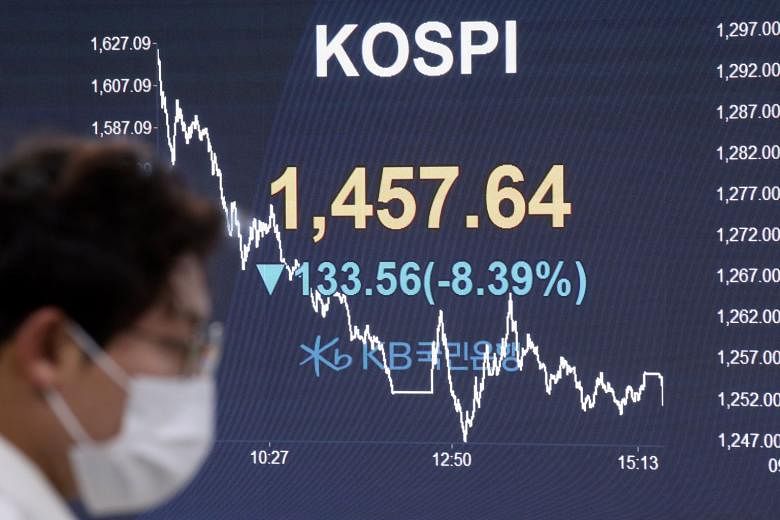SYDNEY (REUTERS, BLOOMBERG) - Amid Asian markets' sea of red, Singapore shares sank on Monday (March 23) with the benchmark index at one point plunging 8.4 per cent, worse than its largest single-day fall on Oct 24, 2008, during the global financial crisis,
The market rout came as a rising tide of national lockdowns threatens to overwhelm policymakers' frantic efforts to cushion what is likely to be a deep global recession.
Singapore's Straits Times Index sank 202 points or 8.4 per cent to its morning low of 2,208.42 as of 10:43am local time.
MSCI's broadest index of Asia-Pacific shares outside Japan lost 3.8 per cent, with New Zealand's market shedding a record 10 per cent as the government closed all non-essential businesses.
Australia's S&P/ASX index plunged 6.8 per cent while South Korea's Kospi Index sank 4.7 per cent.
Japan's Nikkei reversed a slight gain earlier in the mroning on expectations of more asset buying by the Bank of Jaoan and a weaker yen.
Hong Kong's Hang Seng index plunged 4.5 per cent when trading opened, while the Shanghai Composite Index dropped 2.6 per cent.
In a foretaste of the pain to come for US markets, E-Mini futures for the S&P 500 dived 5 per cent at the open to be limit down, while EUROSTOXXX 50 futures tumbled 6.4 per cent.
There was little to cheer in coronavirus news as the global death toll exceeded over 14,000 with more than 300,000 infections.
Airlines cancelled more flights as Australia and New Zealand advised against non-essential domestic travel, the United Arab Emirates (UAE) halted flights for two weeks and Singapore and Taiwan banned foreign transit passengers.
Nearly one in three Americans were ordered to stay home on Sunday to slow the spread of the disease, while Italy banned internal travel as deaths there reached 5,476.
US President Donald Trump went on TV to approve disaster deceleration requests from New York and Washington, while St. Louis Federal Reserve President James Bullard warned unemployment could reach 30 per cent unless more was done fiscally.
Analysts are dreading data on weekly US jobless claims due on Thursday amid forecasts they could balloon by 750,000, and maybe by more than a million.Oil was not far behind as mass bans on travel worldwide crushed demand for fuel.
As investors attempt to assess the severity of the upcoming downturn, Federal Reserve Bank of St Louis President James Bullard predicted the US unemployment rate may hit 30 per cent in the second quarter because of shutdowns to combat the virus.
Markets are "pricing a global recession, which we expect; stay defensive," Goldman Sachs strategists Kamakshya Trivedi and Zach Pandl, wrote in a note on Sunday. "The uncertainties around the depth and duration of the hit to the global economy remain high and the momentum in our own, and other, economic forecasts continues to be sharply negative with downside risks."
US stocks have already fallen more than 30 per cent from their mid-February and even the safest areas of the bond market experiencing liquidity stress as distressed funds are forced to sell good assets to cover positions gone bad.
"It would be a brave, or foolish, man to call the bottom in equities without a dramatic medical breakthrough," said Alan Ruskin, head of G10 FX strategy at Deutsche Bank.
Also needed would be evidence that China can re-emerge from the virus, without reigniting infections and, that other major economies have hit the inflection points for infection rates, he added.
"Even were social distancing to subside at the earliest plausible dates in Europe and the US, it will have done extraordinary damage to confidence in a host of key sectors."
The mounting economic toll led to a major rally in sovereign bonds late last week, with efforts by central banks to restore liquidity in the market allowing for more two-way trade.
Yields on the benchmark US 10-year note were down at 0.80 per cent, having dived all the way to 0.84 per cent on Friday from a top of 1.28 per cent.
In New Zealand, the central bank announced its first outright purchase of government paper aiming to inject much-needed liquidity into the local market.
In currency markets, the first instinct on Monday was to dump those leveraged to global growth and commodity prices, sending the Australian dollar down 0.8 per cent to US$0.5749.
The US dollar started firm but took a step back after partisan battles in the US Senate stopped a coronavirus response bill from advancing.
The dollar eased 0.5 per cent to 110.23 yen, while the euro recouped losses to be up 0.1 per cent at US$1.0707. Against a basket of currencies the dollar was still a fraction firmer at 102.510.
The dollar was a major gainer last week as investors fled to the liquidity of the world's reserve currency, while some funds, companies and countries desperately sought more cash to cover their dollar borrowings.
"Further dollar strength would not be helpful for the US or global economies, and in our view policymakers should consider direct intervention, in addition to further enhancements to central bank USD liquidity facilities," said analysts at Goldman Sachs in a note.
"We expect the dollar to remain firm against most crosses until policymakers intervene and/or market conditions begin to stabilize."
The steady rise in the dollar undermined gold, which slipped 0.3 per cent to US$1,493.83 per ounce.
Oil prices turned mixed after opening sharply lower. Brent crude futures slipped 69 cents to US$26.29 a barrel, while US crude gained 30 cents to US$22.93.











